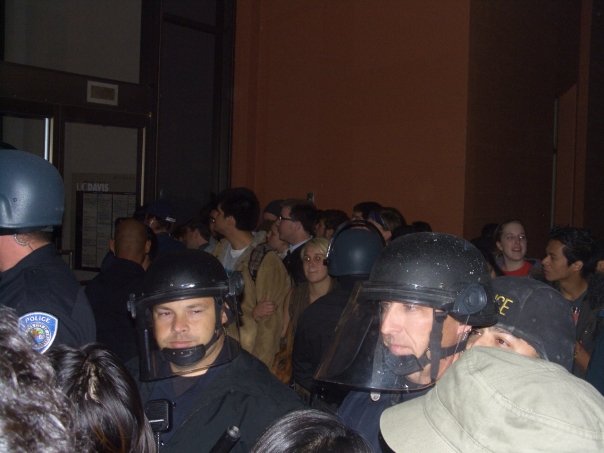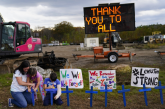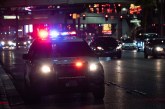
He offers specific reference to UC Davis in his comments dated December 2009, the irony is that unlike the past, I think the UC Davis officials and administrators fared fairly well. The situation that occurred was tense, it was perhaps dragged out too long as the students occupied Mrak Hall, but unlike the past, the university comes across of sympathetic and reasonable. Had they followed Dr. Garland’s advice, the situation would likely have escalated rather than de-escalated.
Dr. Garland argues here that once leaders of a protest become unreasonable and heated in their rhetoric further negotiation becomes unproductive.
“The leaders of disruptive and confrontational protests pose a particular challenge to university administrators, because they usually are not open to reasoned discussion and they are unlikely to ameliorate their stance in light of new knowledge… Such persons are difficult to reason with because they do not have a balanced picture of reality. They live in an anger-driven, black-and-white world of un-nuanced arguments, where it is acceptable to ignore facts and take them out of context, and to reject summarily options, tradeoffs, and compromises.”
He continues:
“Hence these words from a recent UC-Davis protest website: “The administration lies. The police lie. We are done negotiating with the administration, we’re doing things on our terms now: direct action, occupation, reclaiming public space.”
Once rhetoric reaches this stage, further negotiation with protest leaders becomes unproductive. Acquiescing to protester demands in this situation is unwise because doing so merely raises the stakes and results in more demands.”
There is certainly some truth to that, however, his strategy treats the entire body of protesters as though driven by the extremist, rather than understanding that the extremist core can be cut off from the main body of protesters. The extremist core may indeed be unreasonable, but by being reasonable and accommodating, you can limit the next protest to a few zealots rather than having a large protest. He seems to ignore this fact in going through the list of guidelines.
I shall respond to that list and then explain why the university this time responded better than they did a few years ago with the Sodexho protests.
First, he suggests that University officials should be very cautious about having off-the-record conversations with protest leaders. Fair enough. “I have been burned more than once by having my words distorted and quoted out of context. One should not assume that protest leaders will honor confidences and present opposing viewpoints fairly.” However, there are certainly steps that can be taken to mitigate such concerns. Instead he continues with step two.
“Protest leaders often demand to meet directly with the campus president or chancellor. Such meetings should generally not be granted for two reasons: first, doing so symbolically enhances the stature and power of the protest leaders and gives credibility to their actions. And second, doing so marginalizes the dean of students, or campus judicial authorities, or whoever would be the established conduit for complaints.”
However, he ignores the fact that meeting with the President also allows the protesters to have a “win” and enables them to claim victory without gaining any concessions. A meeting can often diffuse the rest of the protest and it can start the road to dialogue. One of the most effective displays of going against this was when hundreds of angry high school students and parents marched on the Davis Unified School District Administrative Building. The Superintendent, James Hammond, instead of hiding in his office, came out with a bullhorn and addressed the protesters, expressed sympathy for their position but ultimately told them of the problems. It completely diffused the rally.
Nothing inspires protesters more than the picture of the President or Chancellor hiding from the students. It gives them a sense of siege mentality and the idea that the leader is cut off from the people and see him or herself as above it all. The best way to diffuse things is to bring the leader to the people, if you fear a face-to-face in private, come out and address the crowd–yourself and not through aids or subordinates.
“Presidents should always keep in mind that a key goal of protests is to attract media attention, which is why protests and demonstrations are held in public places. But drawing media attention to themselves does not mean that protest leaders necessarily seek broad public approval.”
He has a point here that many of the protest leaders probably do not understand the dynamics of public opinion and approval. Sometimes a protest will trigger a backlash, however, the more heavy-handed and unreasonable the administration seems, the more effective the protest. The accommodating administration will appear most reasonable and diffuse public opinion.
“By contrast, university presidents must always try to reduce community polarization and division. Thus, they should remember that the public-at-large does not speak with one voice. On any issue there will be those who see the protests as completely appropriate and desirable, as well as those who believe the protesters should be vigorously prosecuted. When making public statements, therefore, university presidents must always be temperate and even-handed. They should never assume they are speaking only to their supporters. Former president Bush made this elementary error when he failed to realize how language that would resonate positively with his political base could be seen as offensive to those of a different persuasion.”
He is correct here.
He continues:
“Once a campus protest becomes confrontational, its leaders require adversaries to push against. Typically, this entails demonizing the campus chancellor or president in order to make it appear as if the university opposition to their activities is the personal action of an autocratic, insensitive, or greedy leader… Again speaking from experience, the best way to defuse personal attacks is by not becoming rattled, avoiding responding in kind, and never failing to remain objective and even-handed. Presidents should also never, ever try to be funny. In the emotion-laden environment of a campus protest movement, an off-hand attempt at humor is guaranteed to backfire.”
Again, this is sound advice. Humor is often seen as insensitivity to the demands of the protesters rather than a way to diffuse the protest.
He continues:
“A common strategy during a building occupation is for protest leaders to disobey orders, say, to evacuate an office, in order to provoke the police into arresting them. This behavior is intended partly to garner sympathy from TV viewers who might be offended at the sight of young college students being dragged away in handcuffs.”
He goes on to suggest videotaping and statements that
“accusations about police overreaction are standard protest rhetoric, and that campus police are professionals who have been specifically trained in crowd control methods, that they are well aware of the importance of showing restraint, and that their only goal is to enforce the law and protect individuals and public property.”
What the point here misses is that sometimes police do overreact and so the idea that somehow the university is going to credibly claim that police are professionals, particularly campus police, may not diffuse the situation.
The protesters want to be arrested. So there are two ways to go about diffusing the situation. One was what I witnessed at the corner of Anderson and Russell on May 1, 2009. The protesters sat in the street, they had clearly planned to get arrested. The police waited for the bystanders to clear, and then very orderly escorted the protesters into waiting vans. Nothing to see and the police looked like a bunch of professionals.
But if people are in a public building, the other alternative is not to arrest people. Contain the problem and then wait for the students to leave on their own accord. Nothing to see. And guess what, handle it that way, and they probably won’t do it again. Now if they begin to go beyond trespassing to vandalism, that is a different matter, but then it becomes more than civil disobedience. The point here is why give the protesters what they want and assume you can diffuse it with rhetoric in the media.
“University leaders should make it clear at the outset of a confrontation that any negotiation over terms and issues will take place only after the inappropriate activity has ceased.”
That may actually cause escalation. What you need to understand is that a protest is looking to gain something, a small thing to gain would be to have open discussion. And open discussion actually makes both sides look good.
Finally and the point I agree with the least:
Universities should never agree to grant amnesty to protesters, because doing so establishes an unacceptable precedent and sends a message to protesters that staging illegal confrontations are a way to accomplish their aims and that there will be no consequences for their actions.
Thus administrators at the University of California at Davis recently made a error of judgment when, to end a building occupation, they agreed that “in the spirit of continuing dialogue, the university will not pursue student disciplinary actions,” and, further, that they would ask the local district attorney that he “strongly consider his option not to file charges.” It is understandable that administrators would want to defuse a potentially explosive situation, and also would want to appear conciliatory and moderate to the rest of the campus community. However, there is a price to be paid by conceding to demands made under the implicit threat of protesters to elevate the disturbance. Dismissing charges, granting amnesty, or merely slapping the wrists of offenders may be appropriate in many circumstances, but that decision should be the outcome of due process and a disciplinary review. Universities should never agree to preempt the review itself.
The UC-Davis example illustrates the importance of setting policies during a time of calm. Such policies should state that the university will without exception hold accountable those who fail to comply with laws and university regulations. The university should explain clearly what types of activities (destroying property, occupying offices, etc.) are prohibited, and that it is standard practice to collect the names of lawbreakers. Students can get caught up in the passions of the moment and should be reminded that there is a line that they must not cross. The time to do this is before the need arises.
I would argue that this strategy helped the Administrators and even the District Attorney and harmed the students. Two and a half years ago with the Sodexho protests, the university and DA’s office continued to press charges against the students, in fact, the students in one of the protests had been illegally arrested during operating hours of Mrak Hall. By continuing to press charges against students and workers, the university looked unreasonable and the public gained sympathy for the plight of the Sodexho workers. The university was ultimately forced to give them a contract along the lines of what they wanted.
Flash forward to this year. The students occupy Mrak, they wait until the building is closed, they eventually arrest the students when they refuse to leave, and then they enter into discussions and have the charges not filed. Now the University is holding the high ground, the students have lost their message about the unreasonable university, is it more or less likely they attempt the same tactic next time? And if they do, the charges are still potentially there to be amplified. It was a brilliant move rather than what he called an error of judgment.
The bottom line is that protesters would actually prefer his hardline tactics to those that were carried out because the public relations game is to gain sympathy and make the university look unreasonable and frankly it looks unreasonable to refuse to talk, to have protesters asking to talk to officials and not gain access. Protests are going to happen, but the quicker they can be directed toward actual and positive steps like dialogue the better off it is for everyone involved. UC Davis officials ought to ignore this advice and proceed as they have.
—David M. Greenwald reporting






This is interesting. According to Wikipedia, Garland retired as president in 2006 and now lives in New Mexico. His background is physics. So I don’t know what particularly qualifies him to be writing any handbook on the subject in the first place, except perhaps as reminiscences about his own experiences. There is an entire industry of professionals and consultants in the field of conflict resolution. I see little evidence that he made use of that expertise in writing this. It reads more like a field manual written for people used to line authority (don’t undercut your deans?), with greater concern about the public relations aspect of a protest than the actual risk of the situation.
While I appreciate that DMG is responding to a document about controlling a disturbance, I think that it overlooks a fundamental issue – sometimes those engaged in civil disobedience are correct in their assessment that “business as usual” is not a sufficient response to an injustice. What I would add is that the university administration in a case such as this should be proactive, and do all that it can to give voice to those for whom a 30% increase in “fees” is a financial and educational disaster. Ultimately the interests of the university and the students converge – both should want accessible, affordable education. I am not naively saying that there are not potential provocateurs on either side in such a confrontation, those that want to demonstrate power through violence. But if you address the conditions that are moving to civil disobedience normally law-abiding students or citizens, you stand a better chance of resolving a situation without violence.
[i]There is an entire industry of professionals and consultants in the field of conflict resolution.[/i]
But, among other accusations, the protests blast the administration for spending too much on consultants.